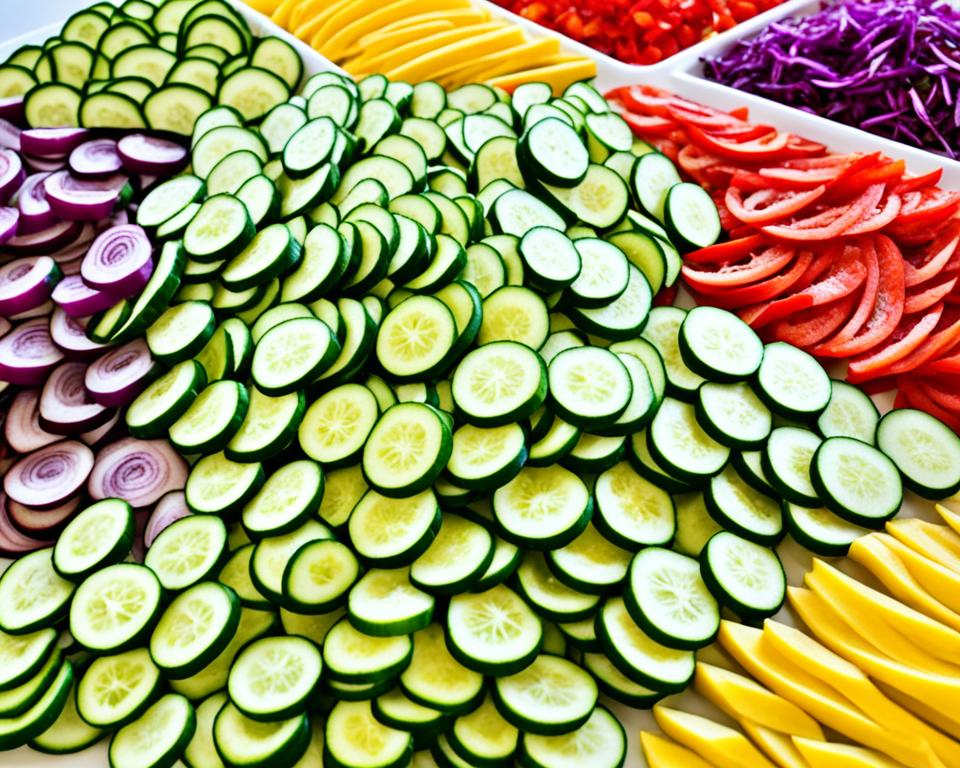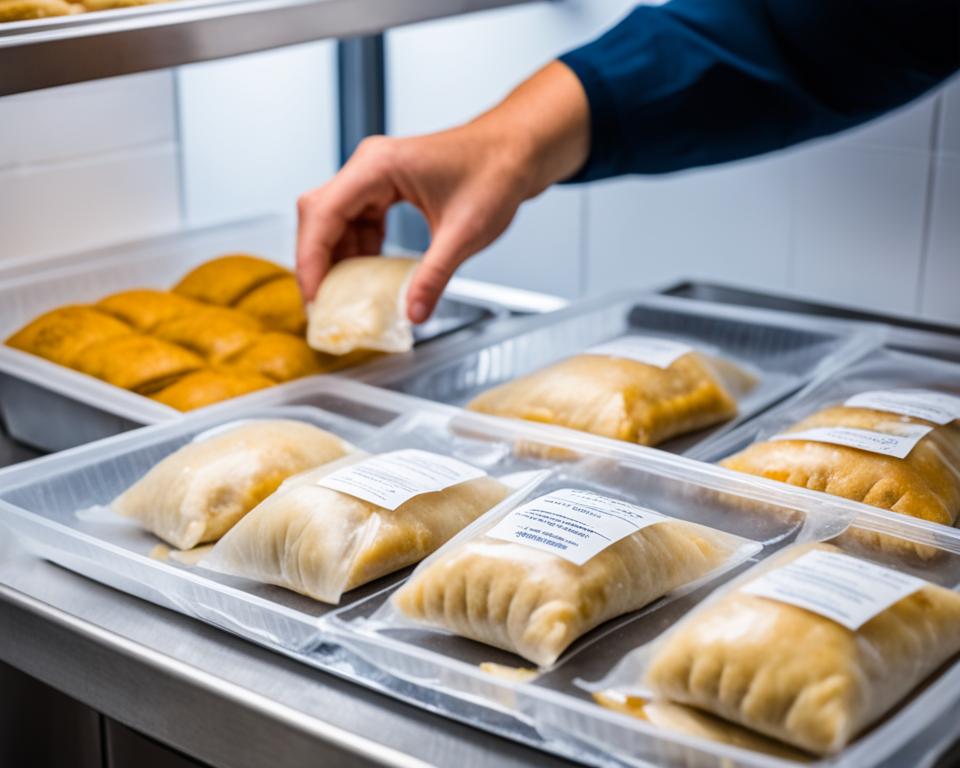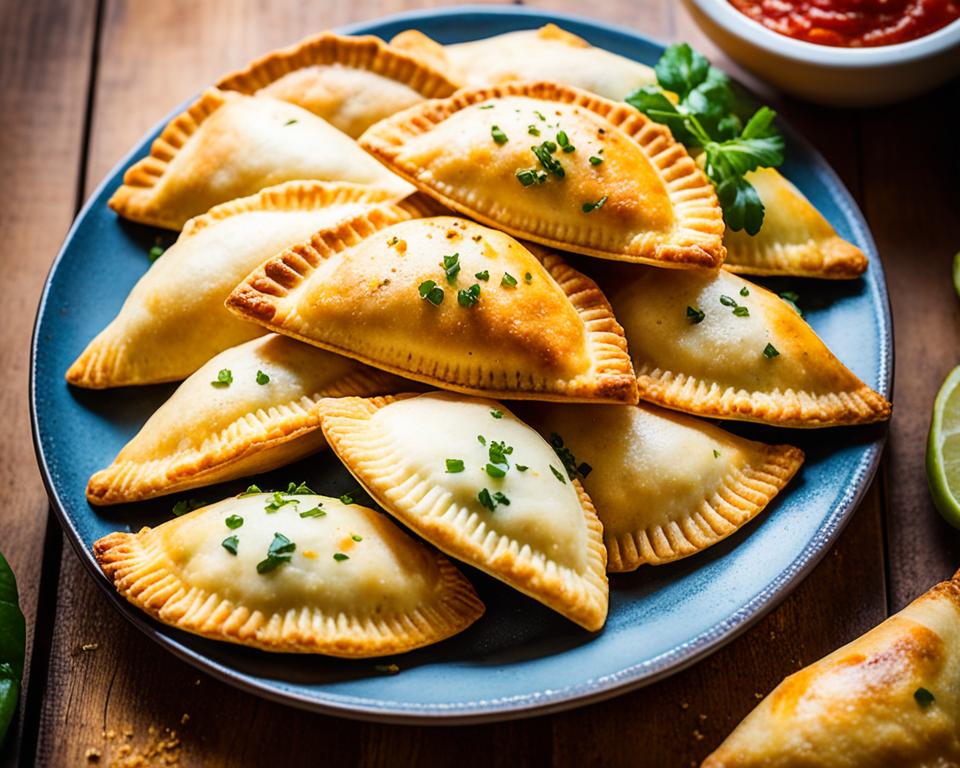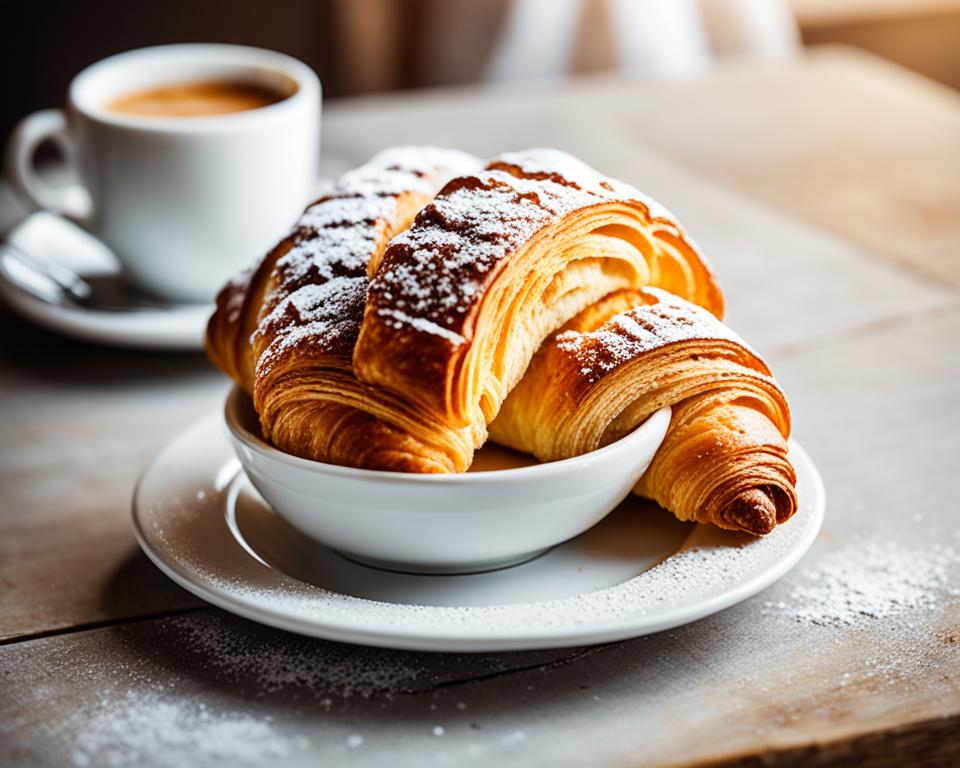Imagine biting into a perfectly golden empanada that’s flaky on the outside, rich and savory on the inside, nestled in a delicious empanada dough that practically melts in the mouth. This dream can be a delightful reality with our easy empanada recipe, designed for both novices and seasoned bakers alike. Whether it’s the subtle, tender crunch of baking empanadas in the oven or the seductive aromas wafting through the kitchen, the experience of crafting and savoring homemade flaky empanadas is unmatched.
Those who appreciate fine textures will revel in the buttery crispness of the crust—an experience akin to the indulgence of French pastries. Inside, the meaty heartiness of the beef and potato filling ensures each bite is a foray into flavor paradise. This is more than a recipe; it’s a culinary journey packed with customizable options to suit any palate or preference—promising perfections in every bite!
Embark on this empanada adventure and prepare to impress yourself, your family, and your guests with a mouthwatering masterpiece. It’s more than food; it’s an expression of love through the art of baking!
Key Takeaways
- Achieving a flaky crust for empanadas is accessible with simple, high-quality ingredients and a touch of patience.
- The savory beef filling, mingling with soft potatoes, guarantees a richly satisfying taste with every bite.
- This easy empanada recipe is a gateway to exploring a variety of fillings, from meats to cheeses to vegetables.
- Emphasizing the joy of baking empanadas, the process proves to be a deliciously creative endeavor that can be planned ahead of time.
- Homemade empanadas, with their adorable appearance and undeniable deliciousness, are bound to become a treasured dish for any occasion.
Introduction to Flaky Empanadas
Empanadas, quintessentially Latin American pastries, have gained immense popularity for their versatility and deliciousness. Often described as the perfect hand-held meal or snack, these crescent-shaped delights are traditionally stuffed with a variety of savory empanadas fillings that burst with flavor. The delicate, flaky exterior of homemade empanadas offers a satisfying contrast to the rich and warm interior, making them a favored choice across the globe.
The beauty of empanadas is their adaptability; from the robust, meaty fillings to the lighter, vegetable-based options, there is a combination to suit every palate. For those seeking empanada filling ideas, the sky’s the limit. You can experiment with different combinations of meats, spices, and vegetables to create a centerpiece that guarantees the empanada’s signature burst of taste with each bite.
- Create an array of fillings featuring traditional Latin flavors or global twists.
- Design an empanada with the richness of beef, the subtlety of chicken, or the freshness of garden produce.
- Enjoy the process of crafting the dough and personalizing it with your favorite ingredients.
Whether you’re entertaining guests, need a quick dinner option, or just looking for a fun culinary project, empanadas are a satisfying solution. Follow along for detailed instructions on how to achieve that perfectly golden, flaky texture that empanada enthusiasts covet, and delve into the realm of fillings that transform simple dough into a delectable treat.
The Ultimate Dough for Golden Empanadas
Embarking on your journey to create an easy empanada recipe starts with the crucial first step of crafting a delicious empanada dough. A deceptively simple blend of pantry staples, cold unsalted butter, all-purpose flour, salt, and a splash of vinegar, can produce a dough that rivals the best patisseries. This foundation is not just a component of the empanada; it is a literal and figurative vehicle for culinary artistry. The key to achieving a pastry with such desired flakiness is in maintaining the chill of your ingredients, ensuring that the butter remains in small, distinct pieces within the dough.
For those yearning to recreate the charisma of homemade empanadas in their own kitchen, the process is quite inviting. It begins with the butter and flour, which come together in a rhythmic dance of knives or pulses of a food processor, culminating in a crumbly, pebbly texture. The addition of cold liquid binds this mixture, and once mixed and rested, offers a pliable canvas ready to be filled with a medley of savory concoctions.
- Mix flour, salt, and cold, cubed unsalted butter until pea-sized crumbs form.
- Stir in chilled water and vinegar to bring the dough together.
- Turn onto a floured surface and shape into a flat rectangle before refrigerating.
- Rest the dough to allow the moisture to distribute evenly.
- Roll out the dough, cut into circles, and fill with your choice of ingredients for golden empanadas.
The empanada dough, now veiled in mystique, is silently promising to turn golden and crisp in the heat of the oven. This dough is not only a vessel for flavors but also for memories and shared moments around the table. While it chills and rests, life buzzes around it, building anticipation for the homemade empanadas soon to emerge, golden and flaky, from the hallowed warmth of your oven.
Choosing the Best Fillings for Savory Empanadas
When it comes to homemade empanadas, the filling is where your culinary creativity shines. Whether you favor the traditional or have an itch for something new, there’s an empanada filling idea to satisfy every craving. Let’s explore some of the most enticing options that will turn your savory empanadas into a feast of flavors.

Traditional Beef and Potato Filling
Starting with the classics, a traditional beef and potato filling brings the rich, familiar comfort that has made empanadas a staple in many kitchens. The essence of savory empanadas comes to life with ground beef, tender potatoes, onions, and a blend of spices designed to tantalize your taste buds.
Customizing with Vegetables and Cheese
For those who seek to weave more nutrition into their fare or cater to vegetarian friends, homemade empanadas gleefully accommodate piles of vegetables alongside or in place of meat. Imagine the delightful texture of spinach, mushrooms, or grilled zucchini paired with the melty indulgence of cheese.
Modern Takes on Classic Flavors
Our palates are ever-evolving, and so are empanada filling ideas. Modern renditions pay homage to the past while embracing the playful. Think outside the box with breakfast-themed fillings featuring eggs and bacon, or dive into sweet and savory matchups like pear and gorgonzola—there’s a world of flavors waiting to be encased in delicious empanada dough.
Empanada Filling: The Heart of Flavor
At the core of every empanada is a filling that brims with flavor, combining the richness of meats and the freshness of vegetables. What truly sets apart savory empanadas is their malleable nature, easily adapted to incorporate an array of tastes, from traditional staples to innovative explorations that entice the palate. A well-crafted filling not only satisfies hunger but also reflects cultural traditions and personal tastes.
Exploring Savory Meat and Vegetable Combinations
The true essence of popular empanada flavors lies in the harmonious blend of savory meats and vibrant vegetables. A union of finely minced beef or chicken intricately intertwined with diced bell peppers, fragrant onions, verdant peas, and piquant garlic creates a filling that is as hearty as it is comforting. These classic combinations are crowd-pleasers known for their ability to deliver homestyle warmth with each bite.
Add-ins for a Personal Touch
To distinguish empanada variations, aficionados of this delicious pastry often include preferred add-ins that lend a personal touch. Olives lend brininess, raisins introduce sweetness, while hard-boiled eggs offer a textural contrast. Such embellishments infuse the empanada with depth and personality, allowing the maker to leave an indelible mark of their own culinary identity.
Incorporating these elements into the filling not only adds distinct flavors but also turns each empanada into a conversation piece, a reflection of the maker’s heritage or inventive spirit.
The Balance of Spices and Herbs
A mastery over the balance of spices and herbs is what turns good empanadas into great ones. The kick of cumin, the zest of oregano, and the subtle heat from a dash of red pepper flakes can transport savory empanadas to new heights. Freshly chopped cilantro or parsley can brighten the overall palates, while a hint of smoked paprika can impart a sophisticated undertone to the filling.
It is this intricate layering of flavors that characterizes the most memorable empanada experiences, ensuring that each bite delivers not just nutrition, but a tapestry of tastes that are both nuanced and bold.
Mastering the Folding Technique for Flaky Empanadas
Creating homemade empanadas with a crispy finish is truly an art that begins with the delicate process of folding. Master this technique, and you will lock in the delectable flavors and ensure your empanadas are both eye-catching and leak-free. For those seeking to craft an easy empanada recipe with a professional touch, understanding the nuances of proper empanada folding is key to achieving that signature flaky texture that makes this dish a beloved culinary treasure.
Creating the Perfect Seal to Lock in Flavors
Ensuring that your filling is perfectly enveloped within the empanada dough is critical. This not only creates a pocket of robust flavor but also prevents any of the contents from spilling out during the baking process. To achieve this, one must roll out the dough into even circles, spoon the filling into the center without overstuffing, and then meticulously fold the dough over to create a semi-circle shape. Pressing the edges to seal is a careful balance of pressure – enough to tightly close but gentle to not rupture the fragile dough.
Tips for a Beautifully Crimped Edge
- Begin by pressing the edges of the folded empanada with a fork, creating a series of uniform indentations.
- Alternatively, fold and twist the edges of the dough using the repulgue method, which adds a decorative flair.
- The goal is to ensure a melding of layers that won’t part ways during their crisp transformation in the oven.
Preventing Leaks and Breaks During Baking
To ensure your crispy empanadas retain their shape and succulence while baking, consider chilling the assembled empanadas before baking. A brief sojourn in the refrigerator helps to solidify the fats, which in turn fortifies the seal. It’s a small step with big returns: a batch of homemade empanadas that bake to perfection, exuding a seductive aroma and sporting a satisfyingly crispy crunch.
| Folding Technique | Sealing Method | Pre-Bake Tip |
|---|---|---|
| Evenly rolled dough circles | Fork pressing or decorative repulgue | Chill empanadas to solidify the dough |
| Centric filling placement to avoid overstuffing | Ensure tight closure to prevent leaks | Check for any cracks or openings before chilling |
Perfect your folding technique, and you’ll be well on your way to serving up homemade empanadas that boast a crispy empanada shell with a flaky, golden texture guaranteed to impress.
Empanadas from Around the World: A Cultural Exploration
Empanadas transcend borders and oceans, presenting a smorgasbord of empanada variations rich in history and flavor. These stuffed pastries have embarked on a global journey, adopted by a myriad of cultures, each infusing them with local ingredients and unique culinary techniques. In every corner of the world, they carry hints of home and heritage, offering a savory piece of culture that’s as enjoyable as it is diverse.
Discovering Variations from Latin America and Beyond
Empanadas resonate with the essence of Latin American cuisine, yet adorn many different regional robes. Across this vibrant continent, every country, from the pampas of Argentina to the coasts of Colombia, exhibits its own esteemed versions. Their adaptability is reflected in the inexhaustible range of popular empanada flavors which celebrate indigenous traditions and contemporary cravings alike.
Regional Differences in Empanada Recipes
In Argentina, empanadas are irresistibly flaky, piquant with a filling that often carries a hint of spice; while in Brazil, pastéis stand tall with their crispy, golden exterior. Contrastingly, Chile offers a sweeter touch to the empanada narrative, often using seafood or cheese to create a luscious savory palate. These regional characteristics reflect not only local preferences but also the adaptability and universality of savory empanadas.
The History and Evolution of Empanadas
The history of empanadas is a tale of travel and transformation. Tracing back to Iberia, these hand-held pies took shape as cultures intermingled, evolving with each diaspora. A cousin to the Cornish pasty, a sibling to the Italian calzone, and an adaptation akin to the beloved samosa, the empanada has stood witness to the world’s appetite for filling-encased dough from its humble inception to its current status as a global gastronomic icon.
| Country | Empanada Name | Typical Fillings | Unique Characteristics |
|---|---|---|---|
| Argentina | Empanadas | Beef, chicken, corn, ham & cheese | Spicy meat, baked or fried, to suit local tastes |
| Brazil | Pastéis | Meat, cheese, hearts of palm | Thin, crispy crust, often deep-fried |
| Chile | Empanadas de horno | Seafood, pine nuts, cheese | Sweet and savory fillings, traditional for Independence Day |
| India | Samosa | Potatoes, peas, lentils, spices | Triangular shape, spiced vegetarian fillings, deep-fried |
Flaky Empanadas
When one dreams of crispy empanadas, the imagery is incomplete without that quintessential, flaky texture that creates a symphony of sound and taste with each bite. The craft of empanada-making is elevated to an art form when the result is an empanada that boasts a golden, buttery case, giving way to a rich, savory filling that has been carefully encased within delicious empanada dough.
The pursuit of the best empanada recipe culminates in mastering the dough, the foundation upon which the delicacy stands. Painstakingly mixing the dough, attentively keeping ingredients cool, and exacting measurements converge to ensure the dough achieves the levels of flakiness and taste that are emblematic of a premium baking endeavor.
Patience will be your cherished ally in this process; chilling the fat and avoiding overworking the dough will lead to the creation of those prized buttery layers. Your reward is a pastry that’s delightfully crispy, invitingly brown, and irresistible to the last crumb, exemplifying the tender care and precision invested in crafting the definitive flaky shell.
- Source the finest cold butter to provide the much-needed flakiness.
- Integrate the butter into the flour until the mixture resembles coarse sand.
- Carefully add ice-cold water to bind the dough, ensuring it retains its integrity for the flakiness needed.
- Chill the dough before handling further, as the cold dough contributes significantly to the flaky finish.
- Gently roll out and cut into rounds, ready to envelop your chosen fillings.
- Bake until the empanadas reach a glistening golden hue, indicative of the exquisite texture within.
As your delectable crispy empanadas cool slightly after their oven journey to crispness, they stand ready to be the highlight of any culinary gathering, an exemplar of the traditional handmade art interspersed with your own touch of personal joy in cooking.
Perfecting the Texture: Crispy Outside, Tender Inside
The pursuit of the quintessential empanada experience centers around one crucial element: texture. The goal is to achieve that perfect bite—a harmonious interplay between the crispy exterior and the succulent, tender filling. It’s what sets apart a good empanada from the unforgettable; where the delicate crunch of the outer layer, a result of the meticulous preparation of flaky empanadas, meets the savory, juice-laden interior that makes our palate sing.
Creating an empanada that satisfies this dual texture profile begins with the foundation of all empanadas—the dough. To aid in forming those coveted flaky empanadas, chunks of cold butter are incorporated into the dough. As the empanadas bake, these chunks of butter steam and create airy pockets within the dough, resulting in that essential flakiness we all crave. This phenomenon is not accidental; it’s a deliberate process, playing on temperature, timing, and technique.
Yet, constructing the perfect empanada isn’t merely about the dough—it’s also balancing the filling. Not too much, not too little; just the right amount to allow the dough to fully encapsulate the flavor without stretching or dripping out. The ratio of filling to delicious empanada dough is all about geometry—ensuring even distribution and optimal baking conditions for achieving that signature golden hue and crispy empanada coat. Let us explore further the steps to achieve such desired textural perfection.
- Ensure butter is cold and cut into the flour until the mixture resembles coarse sand, which promotes flakiness.
- Assess the moisture of your dough; it should be pliable, not sticky or crumbly, to allow for seamless rolling and shaping.
- When spooning your filling onto the dough, leave enough border to fold and seal effectively, preventing potential leaks.
- Avoid overstuffing, which can lead to breaks or bursts, compromising both texture and presentation.
- Chill your shaped empanadas before baking; this step solidifies the fats, reinforcing the texture of the crispy empanada crust.
The final test comes when the empanadas are introduced to the oven’s heat. Precision is key—too high of heat, and the dough crisps before the interior finishes cooking; too low, and the empanada remains pale and doughy. The sweet spot? A temperature that allows our dough’s embedded water and butter to vaporize slowly, creating that imperative puffing that equates to crunch. The emergence is a batch of golden, steaming pastries promising a textural delight with each delightful bite.
By adhering to these principles, you ensure each empanada is a testament to your culinary skills—a symphony of crispy empanadas masterfully brought to life with loving hands and a keen sense for that indescribable flaky, comforting texture.
Baking Vs. Frying: Achieving the Ideal Crust
Choosing between baking and frying can drastically affect the outcome of your homemade empanadas. For those on a quest for the best empanada recipe, the goal is a crispy empanadas crust that’s golden and satisfying to the last crumb. Baking is lauded for its capacity to yield a flaky texture and a healthier profile, as it circumvents the greasiness that frying might entail.
In contrast, frying empanadas is the time-honored method preferred by some, claiming it imparts an unbeatable crispness and rich color. It’s not just the texture and flavor at stake; convenience and post-cooking cleanup also come into play. Those who value an easy empanada recipe might lean towards baking, for a fuss-free method that doesn’t leave lingering aromas or require dealing with used oil.

Ultimately, the choice between baking or frying is more than a culinary one; it’s a personal preference based on one’s priorities for health, convenience, and taste. Let’s compare the pros and cons of each method in a comprehensive table:
| Method | Texture | Health Factor | Cleanup | Flavor Profile |
|---|---|---|---|---|
| Baking | Crispy and Flaky | Lower in fat | Minimal | Light and buttery |
| Frying | Crispiest | Higher in fat | Moderate (oil disposal) | Rich and indulgent |
Each method has its loyalists, and there’s no wrong choice. Whether you choose the baked route for a lighter option or fry them to golden perfection, the journey to crafting crispy empanadas is an enjoyable and rewarding part of the culinary arts.
Hosting an Empanada Party: Serving and Presentation Ideas
Throwing an empanada party is a fabulous way to bring friends and family together over a shared love of delicious, flaky pastries filled with savory delights. With an easy empanada recipe in hand, anyone can turn their gathering into an interactive feast. Here, we delve into creative ways to serve and present these versatile treats that will thrill your guests and make your event unforgettable.
Arranging a DIY Empanada Bar
Create a fun and engaging DIY empanada bar where guests can explore the diversity of empanada variations. Lay out bowls of prepared fillings – from spicy beef to succulent chicken and an array of vegetables for the savory empanadas lover. With pre-made dough circles ready to go, each person can fill and fold their own unique combinations, fostering an experience that’s both personal and communal.
Pairing the Perfect Sauces and Dips
No empanada is complete without the perfect complement of sauces and dips. Offer a selection that ranges from the traditional to the innovative – think tangy salsa, smooth sour cream, and rich guacamole, each adding depth and character to the already delicious parcels. These dips not only enhance flavors but also invite guests to mix and match to their heart’s content.
Empanada Plating Techniques for Events
For a visually stunning presentation, consider creative plating techniques that showcase the golden hue and flaky texture of your homemade empanadas. Arrange empanadas on a slate board or a rustic wooden platter to emphasize their artisanal appeal. Garnishes such as fresh herbs provide a pop of color, while baskets lined with patterned cloths add a homely touch to the party spread, making it all the more inviting.
With these ideas, your empanada party will become a memorable occasion where every guest can enjoy crafting and indulging in their own perfect pastry creations.
Storing and Reheating: Keeping Empanadas Delicious
One of the many delights of creating homemade empanadas is the abundance they yield, often leaving a few to be savored for later. Properly storing and reheating empanadas is essential to retain the rich taste and perfectly flaky texture that characterizes the best empanada recipe. Here are some tips to ensure your empanadas remain as delicious as when they first emerged from the oven.
For those empanadas that manage to escape immediate consumption, cooling them completely before storage is imperative. Wrap them individually with plastic wrap or aluminum foil, then place in an airtight container. This preserves their moisture and flavors, staving off any undue dryness or sogginess. Such care ensures that when it’s time to reheat, these easy empanada recipes yield delights that are as close to fresh as possible.
Vying for the best results when warming up those leftover empanadas? The oven is your friend. Preheating it to around 400°F and placing the wrapped empanadas directly onto the oven rack or a preheated baking sheet allows for an even, gentle return to their original crispy glory. It’s a little more time-consuming than the microwave, but the even heating prevents the sogginess that microwaves often induce and restores the empanada’s flaky charm.
For those who have mastered the best empanada recipe to such a degree that it yields more than can be immediately savored, freezing is an excellent option. Both baked and unbaked empanadas can be frozen, with the former allowing for quick reheating and the latter promising an experience akin to enjoying them made fresh.
| Storage Method | Description | Reheating Instructions |
|---|---|---|
| Refrigeration | Wrapped and kept in airtight container for up to 3 days | Preheat oven to 400°F and heat until crisp |
| Freezing (Pre-Baked) | Wrap individually, then store in freezer bags up to 3 months | Bake from frozen, adding a few minutes to the original baking time |
| Freezing (Unbaked) | Separate with parchment, store in freezer bags up to 3 months | Preheat oven and bake as per the original instructions, with added time |
The joy of baking and enjoying homemade empanadas should not be short-lived. Proper storage and reheating techniques allow the savoring of your culinary creations well beyond their initial serving. Whether reheating a single empanada as a quick snack or several for a family meal, following these steps ensures that the textures and flavors that define the best homemade empanadas remain consistent every time.
Making Empanadas Ahead: Tips for Freezing and Thawing
For those seeking to discover the best empanada recipe, crafting homemade empanadas can be a delightful, yet time-consuming kitchen affair. To make life easier, especially for busy food enthusiasts, making empanadas ahead of time is an effective solution. This method not only saves precious time but also ensures that the savory empanadas retain their homemade freshness and taste. From preparing the dough and filling in advance to understanding the subtleties of freezing and thawing, these guidelines are designed to keep your empanadas perfect until they’re ready to enjoy.

Preparing the Dough and Filling in Advance
The first step to enjoying savory homemade empanadas at a moment’s notice begins with advance preparation. By creating your empanada dough ahead of time, you can divide it into the desired portions, wrap it securely, and refrigerate it for a couple of days. Alternatively, for even longer storage, you can roll out the dough and freeze it between layers of parchment paper. The fillings, too, can be made ahead of time and stored in airtight containers, preserving the bold flavors that make your savory empanadas stand out.
- Refrigerate dough wrapped tightly in plastic for up to 48 hours.
- Roll out dough and place between layers of parchment to freeze for future use.
- Prepare and refrigerate empanada fillings in airtight containers, ensuring they stay fresh.
Storage Guidelines for Freshness
Whether you’re making the filling from scratch or relying on leftovers to create your filling, proper storage is key to maintaining the freshness and quality of your savory empanadas. Unbaked empanadas can be covered and stored in the refrigerator for up to two days without compromising their flavor or texture. For longer preservation, freezing offers a convenient option, with the ability to keep your homemade empanadas fresh for several months.
- Chill unfilled dough and fillings separately to maintain freshness before assembly.
- Keep unbaked empanadas covered in the refrigerator to prevent drying out.
- Freeze empanadas individually or in batches, making sure they are well-wrapped or stored in freezer-safe containers.
How to Bake Empanadas from Frozen
When the craving for homemade empanadas strikes, having frozen ones on hand can be a lifesaver. To enjoy them, you’ll need to know the right techniques for baking them straight from the freezer. While it may require a few additional minutes in the oven compared to fresh or thawed empanadas, the end result should taste just as if they were prepared from scratch that day. Follow these essential steps for best results when baking your frozen savory empanadas.
- Preheat your oven according to the original baking instructions of your best empanada recipe.
- Place frozen empanadas on a baking sheet lined with parchment paper without thawing.
- Extend the initial baking time by several minutes, ensuring the empanadas are fully heated and the crust becomes crisp and golden.
Healthier Empanadas: Alternative Ingredients for Special Diets
Embracing a healthier lifestyle or accommodating various dietary needs does not necessitate a sacrifice of flavor or texture in empanada-making. By exploring alternative ingredients that cater to special diets, you can create an easy empanada recipe that is both inclusive and equally as tantalizing as the traditional version. From gluten-free and low-carb alternatives to plant-based fillings, the options for crafting delicious empanada dough and savory empanadas are aplenty, ensuring everyone can enjoy this classic dish.
Gluten-Free and Low-Carb Dough Options
Those adhering to gluten-free or low-carb diets can still indulge in the crispy, flaky crust of an empanada. By swapping traditional wheat flour for almond, coconut, or other gluten-free flour blends, a suitable base can be created that satisfies those specific nutritional preferences. These substitutions offer a health-conscious approach to empanada dough, providing an alternative method for achieving the delicious empanada dough experience without compromising dietary goals.
Vegetarian and Vegan Empanada Variations
More and more individuals are leaning towards plant-based diets, and the world of empanadas warmly welcomes them. A medley of mushrooms, lentils, and root vegetables can become the stars of the filling, providing a rich, umami-packed alternative to meat. Vegan cheese and plant-based proteins expand the array of options further, allowing the creation of savory empanadas that are not only vegetarian and vegan friendly but also irresistibly delightful to all palates.
Substitutes for Dietary Restrictions
Dietary restrictions should never keep anyone from enjoying their favorite foods. Ingredients notoriously known for their allergens, like lard or dairy, can be substituted with healthier plant-based oils and dairy-free alternatives without sacrificing the flakiness that makes empanadas so beloved. Such modifications actively embrace inclusivity, providing a way for individuals with strict dietary restrictions to still relish the pleasure of a homemade, easy empanada recipe.
FAQ
What are the key ingredients for a flaky empanada dough?
The key ingredients for a flaky empanada dough include cold unsalted butter, all-purpose flour, a touch of vinegar, and salt. Cold water is also essential to bind the dough while maintaining the butter in small chunks, which is crucial for achieving the flaky texture.
Can I make empanadas in advance and what’s the best way to store them?
Yes, you can make empanadas in advance. The dough can be stored in the refrigerator for a couple of days or frozen between parchment layers. Assembled empanadas can also be kept covered in the fridge for up to 2 days or frozen for several months. For optimal taste and texture, reheat baked empanadas in an oven rather than a microwave.
How can I customize my empanada fillings?
Empanada fillings can be customized in many ways. You can use different meats like beef, chicken, or even seafood, add various vegetables, cheeses, olives, or spices, and use leftovers to create inventive flavors. You can also experiment with sweet fillings such as fruit or chocolate for a dessert version.
What are some popular empanada flavors around the world?
Around the world, popular empanada flavors include the spicy meats of Argentina, the veggie and cheese mixes found in Chile, sweet corn varieties like in Mexico, or even samosas in India, which are similar in concept. European versions might include the traditional meat pies found in Britain.
Is it better to bake or fry empanadas?
Whether to bake or fry empanadas is a matter of personal preference. Baking is a healthier option and can produce a crispy and flaky crust, whereas frying can give a golden crispness that some people prefer. Ultimately, the choice affects texture, flavor, and convenience.
How do I prevent my empanadas from leaking while baking?
To prevent empanadas from leaking, ensure that they are not overfilled and that the edges are sealed securely, either with fork tines or by crimping decoratively. Chill the assembled empanadas before baking to help maintain their shape and integrity during the baking process.
How can I accommodate special diets with empanadas?
For special diets, you can use gluten-free or low-carb dough made with alternative flours, or adapt the fillings to be vegetarian, vegan, or dairy-free depending on dietary restrictions. Substitutes like vegetable-based lard can be used to maintain flakiness while catering to different health needs.
What are some tips for achieving the perfect texture in empanadas?
To achieve the perfect texture, handle the dough carefully to maintain the cold butter chunks, which will create flaky layers upon baking. Also, ensure a proper filling-to-dough ratio for even cooking and a satisfying crunch in each bite without the empanadas bursting at the seams.
How can hosting an empanada party add fun to my gathering?
Hosting an empanada party can be fun and interactive. Set up a DIY empanada bar where guests can choose from a variety of fillings and flavors, provide different sauces and dips, and use creative plating techniques to showcase the pastries and promote communal sharing and enjoyment.
Are there any tricks to making flaky empanadas?
For flaky empanadas, keep all ingredients cold and work quickly to prevent the dough from warming. Use a food processor or your fingertips to incorporate the butter until pea-sized. Additionally, adding a splash of vinegar can help prevent gluten development, which contributes to the dough’s tender, flaky texture.




